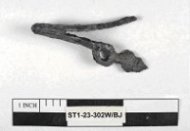Iron Conservation

Iron is found in abundance on archaeological sites yet it remains one of the most unstable materials and therefore it is the most difficult to stabilize and preserve. Iron, or more correctly a variety of ferrous alloys, is grouped by type. Manufactured ferrous alloys usually contain other elements besides iron in their composition and these elements help to stabilize the iron when it is formed into objects. The three main types of iron found on archaeological sites are wrought iron, cast iron, and steel. When iron is found on archaeological excavations it has most likely been processed and manufactured starting with iron ore. Because iron naturally wants to convert back to it’s most stable state –- i.e. the iron ore from which it is made –- it remains unstable through use, burial, and storage in archaeological collections.
Archaeological iron from aerated damp sites appears brown- red- orange in color upon excavation and the shape, identity and details of the object may or may not be discernible. Iron corrodes very rapidly upon burial and the thick, voluminous corrosion can contain inclusions from the soil such as tiny pieces of rocks, shell, sand, coal, organics, and bone. The red-orange color of iron indicates it is an iron-oxide corrosion product of some type. The iron-oxide corrosion layers may also contain soluble salts such as chlorides, and non-soluble salts such as carbonates, sulfates, and phosphates .
Sometimes the entire iron object is consumed by this type of very aggressive corrosion and the original metal core is no longer present. When an iron object is exposed to a burial environment with little to no oxygen, a layer called magnetite forms next to the iron’s surface. This is often identified during cleaning and is thin, dark gray or black in color and is dense and shiny. Iron corrodes so rapidly that the ‘original surface’ of the metal is quickly turned into voluminous corrosion products and therefore the original surface of iron objects can rarely be found. Sometimes the approximate shape of the object may be determined through careful cleaning, but surface decoration, including items such as inlay and wear patterns, along with other technological information, is usually lost or altered during the corrosion process. If the magnetite layer is intact it often protects such details and they will often be revealed during conservation cleaning of the object.
During burial other factors in the environment which can cause ferrous alloy to corrode include oxygen, pollutants, soluble and non-soluble salts, water, and micro-organisms. The pH of the soil is also a factor in determining how much corrosion forms on iron. In very acidic soils [pH 0-5] and very alkaline soils [pH 8+], iron rarely survives. Iron continues to remain unstable post-excavation, and exposure to unstable environmental factors will sometimes cause iron to continue to corrode while it is in the laboratory, on display or in storage. Some of these factors are high levels of humidity, unstable temperatures, pollutants and physical stress from handling. All of these will result in further deterioration unless precautions are taken to slow down or arrest this type of deterioration. It is therefore important to handle, store and exhibit metals in a clean, stable, dry environment so that post-excavation deterioration does not occur. Archival materials are best practice for implementing the long-term preservation of these fragile materials. For more information on the long-term storage of archaeological materials go to Conservation FAQ on the SHA web page.
| Back to Metal Conservation | X-radiography | Case Studies |


